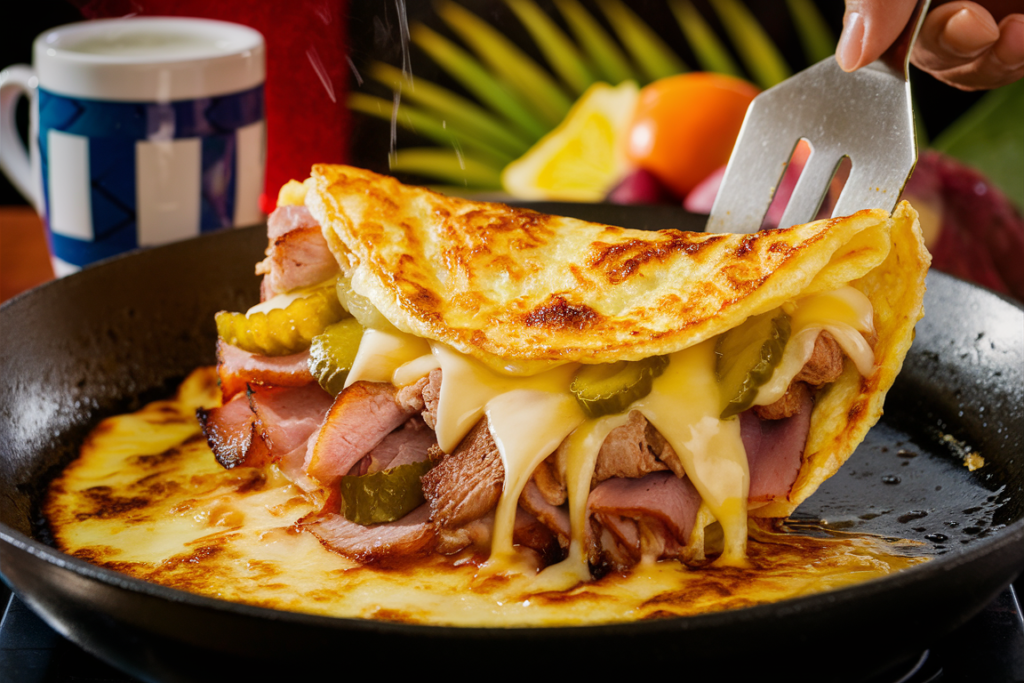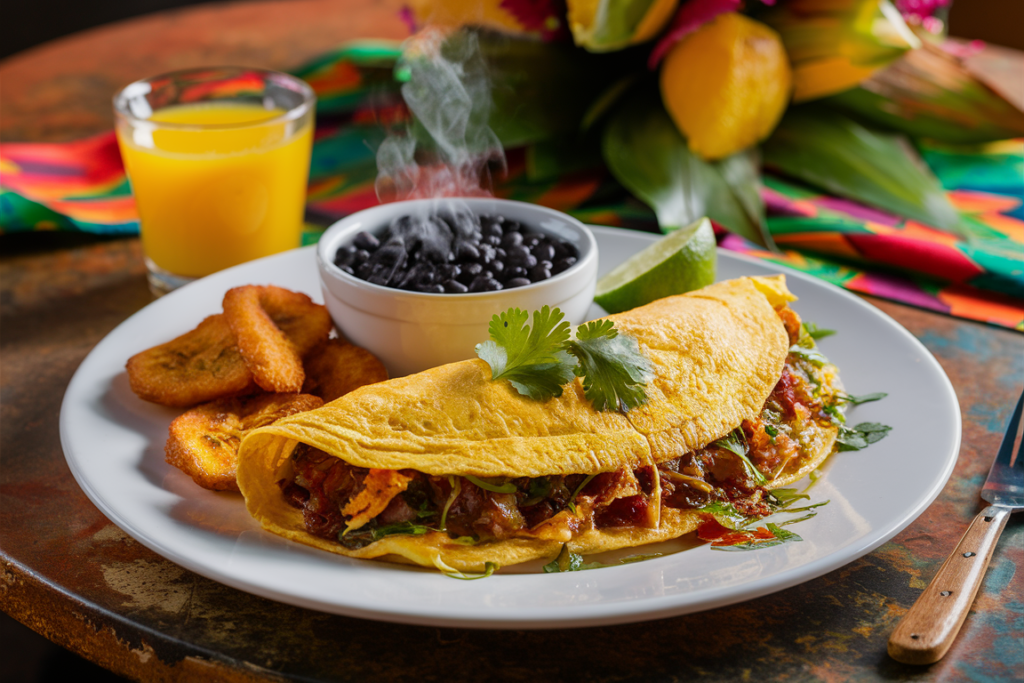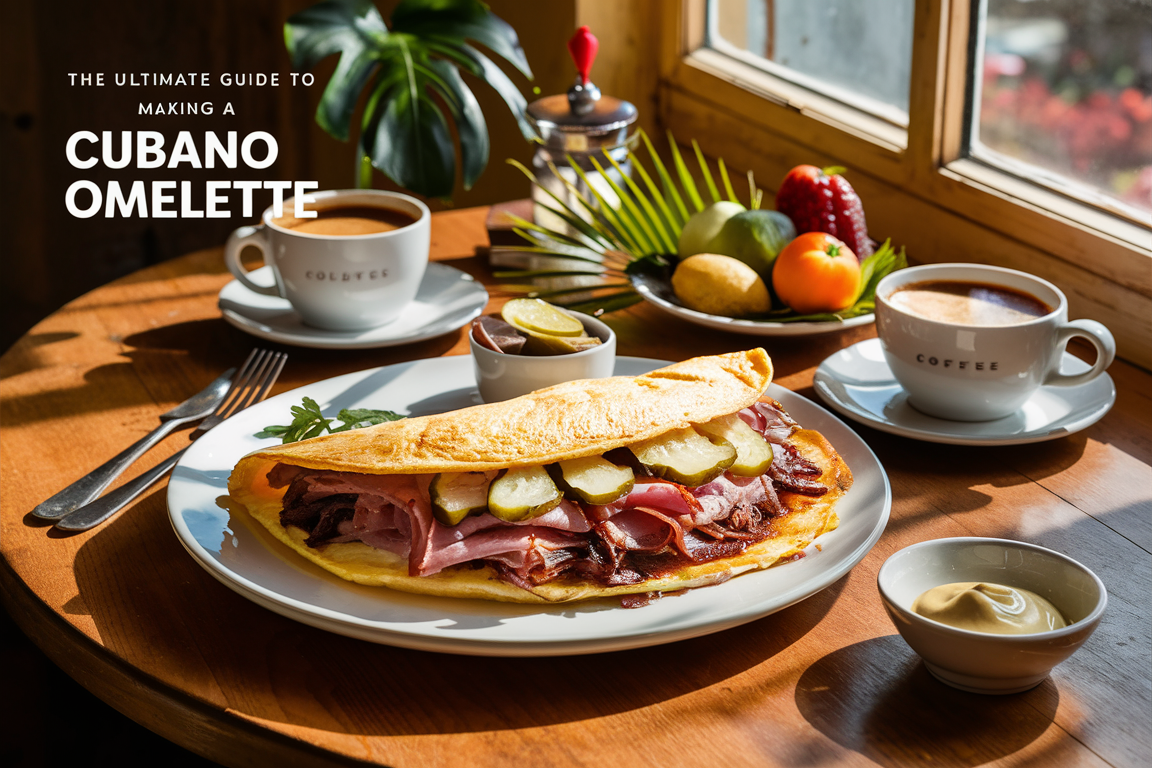Part 1: Exploring the Delicious World of the Cubano Omelette
1. Introduction to the Cubano Omelette
What Is a Cubano Omelette?
The Cubano Omelette is an exciting fusion of classic Cuban flavors with the versatility of a fluffy omelette. Inspired by the iconic Cuban sandwich, this dish brings together the savory elements of ham, roast pork, Swiss cheese, pickles, and mustard within the comforting folds of eggs. It’s a hearty, flavorful option perfect for breakfast, brunch, or even dinner.
Unlike traditional omelettes, the Cubano Omelette stands out because of its bold flavors and the way it reinterprets Cuban cuisine in a breakfast-friendly form. With each bite, you’ll experience a delightful blend of tangy, creamy, and savory notes.

Origin and Inspiration: Cuban Cuisine Meets Breakfast
The inspiration behind the Cubano Omelette traces back to the iconic Cuban sandwich, known for its layers of meats, cheese, and pickles pressed between crusty bread. Cuban cuisine, celebrated for its use of simple ingredients paired with bold seasonings, provides the perfect backdrop for reinventing traditional breakfast fare. This omelette is more than a meal—it’s a cultural homage to the rich culinary traditions of Cuba.
2. The Key Ingredients for a Cubano Omelette
Eggs: The Foundation
Eggs serve as the perfect canvas for this flavorful masterpiece. Their neutral taste allows the robust Cuban ingredients to shine, while their fluffy texture adds a satisfying bite. For best results, use fresh, free-range eggs to achieve a richer flavor and better consistency.
Ham and Roast Pork: Classic Cuban Flavors
The duo of ham and roast pork forms the protein-rich core of the Cubano Omelette. These ingredients bring in the smoky and savory notes that are characteristic of Cuban cuisine. Leftover roast pork from last night’s dinner works beautifully for this dish, making it both practical and delicious.
Swiss Cheese and Pickles: Adding the Signature Twist
Swiss cheese melts into creamy perfection, balancing the sharpness of pickles. The tangy crunch of pickles introduces a unique texture and a hint of acidity, creating a flavor explosion that makes the Cubano Omelette truly distinctive.
Mustard as the Flavor Enhancer
A swipe of yellow mustard adds just the right amount of tang and spice, tying together the other ingredients seamlessly. This subtle yet essential component gives the omelette its unmistakable Cuban sandwich essence.
3. Essential Tools and Equipment
The Perfect Pan for Omelettes
To cook a flawless Cubano Omelette, you’ll need a nonstick pan with excellent heat distribution. An 8- or 10-inch skillet is ideal, as it allows the omelette to cook evenly without sticking or breaking apart.
Spatulas and Whisks: Getting the Right Texture
A silicone or rubber spatula is perfect for folding the omelette without tearing it. Pair this with a balloon whisk to aerate the eggs, ensuring a light and fluffy texture.
4. Step-by-Step Preparation for the Cubano Omelette
Prepping the Ingredients
- Start by whisking 3–4 large eggs until the mixture is smooth and slightly frothy.
- Slice the ham and roast pork into thin strips for even distribution.
- Grate Swiss cheese and dice pickles into small pieces for easier layering.
- Have your mustard ready to drizzle over the cooked layers.
Setting Up Your Cooking Space
Before you begin cooking, ensure all ingredients are within reach. Preheat your skillet on medium heat and grease it lightly with butter or oil to prevent sticking. A well-organized cooking space makes the process smoother and more enjoyable.
5. Cooking Techniques for the Perfect Omelette
Mastering the Art of Fluffy Omelettes
To achieve that cloud-like texture, cook the eggs over medium-low heat, allowing them to set gently. Avoid over-stirring, as this can deflate the eggs and make them rubbery.
Layering Ingredients for Even Distribution
Once the eggs start to set, layer the ham, roast pork, Swiss cheese, and pickles evenly across one side of the omelette. Fold it carefully using your spatula, ensuring that the fillings remain intact and evenly distributed.
6. A Classic Cubano Omelette Recipe
Full Recipe with Measurements
Ingredients:
- 4 large eggs
- ¼ cup cooked ham, sliced
- ¼ cup roast pork, shredded
- 2 tablespoons Swiss cheese, grated
- 1 tablespoon pickles, diced
- 1 teaspoon yellow mustard
- Butter or oil for greasing
Instructions:
- Whisk the eggs until frothy and set aside.
- Heat the skillet on medium and add a small amount of butter.
- Pour in the eggs and let them cook undisturbed until partially set.
- Layer the ham, roast pork, Swiss cheese, and pickles on one side.
- Drizzle mustard over the fillings and fold the omelette carefully.
- Cook for another minute, then slide onto a plate and serve hot.
Alternative Add-Ins for Customization
- Swap Swiss cheese with mozzarella or gouda for a different flavor.
- Add jalapeños for a spicy kick.
- Incorporate caramelized onions for a touch of sweetness.
7. Tips and Tricks for Achieving Authentic Flavors
Using Leftover Cuban Sandwich Ingredients
To save time, repurpose leftovers from a traditional Cuban sandwich—like roast pork or pickles—for a truly authentic taste.
Balancing Saltiness with Freshness
While the ham and cheese provide a salty punch, balance it with a fresh garnish of cilantro or a squeeze of lime to brighten the dish.
8. Pairing the Cubano Omelette with Side Dishes
Cuban-Inspired Breakfast Sides
Elevate your meal with traditional Cuban sides like:
- Fried plantains
- Black beans with rice
- Toasted Cuban bread with butter
Light Beverages to Complement the Meal
Pair your omelette with a cup of Cuban coffee for an authentic experience. Alternatively, opt for a refreshing tropical juice, like guava or pineapple, to cut through the richness.
9. Health Benefits of the Cubano Omelette
High-Protein, Low-Carb Characteristics
The Cubano Omelette is a protein-packed option that fits into low-carb diets like keto. The combination of eggs, meat, and cheese keeps you full and energized.
Nutritional Insights on Key Ingredients
- Eggs: Rich in vitamins and omega-3s.
- Ham and Pork: High in protein and essential minerals like iron.
- Pickles: A low-calorie source of probiotics.
10. Common Mistakes and How to Avoid Them
Overcooking Eggs
Cooking eggs over high heat can make them dry and rubbery. Always use a medium-low flame for optimal results.
Overloading the Omelette with Fillings
While it’s tempting to stuff the omelette, too many fillings can make it difficult to fold and cook evenly. Stick to moderate amounts for the best balance.
Part 2: Diving Deeper into the Cubano Omelette
11. Exploring Variations of the Cubano Omelette
Vegetarian or Vegan Adaptations
While the traditional Cubano Omelette is a meat lover’s dream, it can be adapted for vegetarians and vegans with creative ingredient swaps:
- Replace ham and pork with marinated tofu or grilled mushrooms.
- Use plant-based Swiss cheese alternatives.
- For vegans, use a chickpea flour-based egg substitute like “Just Egg” or a tofu scramble as the base.
These substitutions retain the essence of the dish while catering to different dietary preferences.
Mini Omelettes for Parties or Brunches
Miniature versions of the Cubano Omelette are perfect for brunch spreads or parties. Use a muffin tin to bake egg cups filled with diced ham, cheese, pickles, and a dollop of mustard. These bite-sized treats are easy to serve and add a unique twist to your menu.

12. Cultural Connections: Cuban Sandwich vs. Cubano Omelette
Historical Significance of Cuban Flavors
The Cubano Omelette pays homage to the Cuban sandwich, which originated in Tampa and Miami’s Cuban-American communities. This iconic sandwich represents the blending of cultural influences—Spanish, Cuban, and American—making it a symbol of culinary innovation.
The omelette takes this legacy a step further by reimagining these bold flavors for breakfast, bringing cultural traditions to a new mealtime.
Modern Interpretations
Modern twists on the Cubano Omelette can be found in creative culinary spaces. Restaurants have experimented with ingredients like chipotle aioli, smoked turkey, or even sourdough croutons for added texture, reflecting how global flavors continue to influence traditional dishes.
13. Popularity of Cuban Cuisine Across the Globe
The Rise of Cuban-Inspired Dishes in Fusion Cuisine
From street food stalls to gourmet restaurants, Cuban-inspired dishes have made a mark in global fusion cuisine. The vibrant use of spices, citrus marinades, and fresh herbs has universal appeal. The Cubano Omelette is part of this trend, showcasing how Cuban flavors adapt seamlessly to different culinary formats.
Famous Restaurants Featuring Cubano Omelettes
Restaurants like Versailles in Miami and La Tropicana are renowned for their Cuban fare, often featuring creative breakfast dishes inspired by Cuban sandwiches. The Cubano Omelette is steadily gaining a fan base among food enthusiasts worldwide.
14. Experimenting with Cheese and Pickles
Alternative Cheese Options
While Swiss cheese is the classic choice, other varieties can bring a fresh perspective to the Cubano Omelette:
- Gruyère: Adds a nutty richness.
- Provolone: Offers a mild creaminess.
- Pepper Jack: Introduces a spicy kick.
Creative Uses of Pickles in Cuban Recipes
Pickles are an essential ingredient, but you can experiment with:
- Pickled jalapeños for added heat.
- Bread-and-butter pickles for a sweet contrast.
- Homemade pickle blends using Cuban spices like cumin and oregano.
15. The Science of a Perfect Omelette
Why Cooking Temperature Matters
Cooking the Cubano Omelette at the right temperature is crucial. Low to medium heat ensures the eggs set evenly without burning. Rapid cooking at high heat can lead to a rubbery texture and uneven layers.
Egg Chemistry and Texture
Egg proteins coagulate when heated, creating the omelette’s structure. Whisking the eggs introduces air, resulting in a fluffy texture. Adding a splash of milk or cream can further enhance this effect, creating a soft, cloud-like bite.
16. Hosting a Cuban-Themed Breakfast
Planning the Menu
A Cuban-themed breakfast can include the Cubano Omelette as the centerpiece, accompanied by:
- Freshly fried plantains.
- Cuban-style rice and beans.
- Sweet guava pastries (pastelitos).
The diversity of flavors creates a memorable dining experience.
Table Decor and Music for the Atmosphere
Set the mood with:
- Bright tablecloths and tropical centerpieces.
- A playlist featuring Cuban classics like Buena Vista Social Club or Celia Cruz.
This immersive environment transports your guests to Havana for the morning.
17. Making the Cubano Omelette for Meal Prep
Storing and Reheating Tips
To keep the Cubano Omelette fresh for meal prep:
- Store individual portions in airtight containers.
- Reheat gently in a skillet or microwave to maintain texture and flavor.
Adjusting Recipes for Larger Batches
Scale up the recipe by cooking the omelette mixture in a baking dish to create a casserole-style version. This method is perfect for feeding a crowd while preserving the dish’s signature flavors.
18. Kids-Friendly Adaptations of the Cubano Omelette
Mild Flavors for Picky Eaters
For kids who prefer milder tastes:
- Use honey mustard instead of yellow mustard.
- Swap Swiss cheese with mozzarella or cheddar.
- Reduce the amount of pickles for a subtler flavor.
Fun Presentation Ideas
Make the omelette visually appealing by:
- Cutting it into fun shapes with cookie cutters.
- Serving it with colorful sides like fresh fruit or sweet potato fries.
19. How to Source Authentic Cuban Ingredients
Finding Roast Pork and Cuban Bread
To achieve authentic flavors, source traditional ingredients like roast pork from local butchers or Cuban grocery stores. Cuban bread can be substituted with baguettes if unavailable.
Local Markets and Online Stores
Online specialty shops and Latin markets are excellent resources for finding authentic Cuban spices, pickles, and cheese. Brands like Goya often offer accessible alternatives for Cuban staples.
20. Quick Cubano Omelette Hacks for Busy Mornings
Pre-Chopped Ingredients
Prepare your fillings in advance by slicing and dicing the ham, pork, pickles, and cheese. Store them in airtight containers for easy access during rushed mornings.
One-Pan Cooking Techniques
Streamline the process by sautéing the fillings directly in the skillet before adding the eggs. This hack saves time and reduces cleanup while intensifying the flavors.
Part 3: Mastering the Art and Story of the Cubano Omelette
21. Comparing the Cubano Omelette with Other Regional Omelettes
Spanish, French, and American Omelette Styles
The Cubano Omelette distinguishes itself from other regional omelettes by incorporating bold Cuban flavors. Here’s a comparison:
- Spanish Omelette (Tortilla Española): A thick, layered dish with potatoes and onions, often served at room temperature.
- French Omelette: Known for its silky, custard-like texture with minimal fillings.
- American Omelette: A fluffier, heartier version typically loaded with a variety of fillings.
The Cubano Omelette adds a unique twist by infusing the rich, tangy, and savory notes of the Cuban sandwich, making it a standout breakfast option.
Unique Features of the Cubano Omelette
The combination of ham, roast pork, Swiss cheese, pickles, and mustard is rarely found in other omelettes. This flavor-packed filling, wrapped in fluffy eggs, sets the Cubano Omelette apart as a fusion of cultures and cuisines.

22. Presentation and Plating Ideas for the Cubano Omelette
How to Plate Like a Pro
To elevate the Cubano Omelette’s presentation:
- Fold it neatly and place it at the center of a white plate for contrast.
- Add a side garnish of fresh cilantro or parsley to enhance the colors.
- Drizzle mustard artistically on top for visual flair.
Garnishing with Cuban Flair
For an authentic Cuban touch, serve the omelette with:
- Thinly sliced lime wedges.
- A sprinkle of paprika or cumin for added color and aroma.
- Toasted Cuban bread on the side for a complete meal.
23. Seasonal Adjustments for the Cubano Omelette
Adding Seasonal Vegetables
Incorporating seasonal produce into the Cubano Omelette can add freshness and variety. For example:
- In summer, try adding bell peppers or grilled zucchini.
- In fall, include roasted butternut squash or caramelized onions.
- Winter greens like spinach or kale can balance the richness of the fillings.
Tropical Fruits as Side Pairings
Complement the dish with tropical fruits like pineapple, mango, or papaya. These fruits’ natural sweetness balances the tangy, savory flavors of the omelette.
24. Hosting a Cubano Omelette Cooking Class
Structuring the Class
To teach the art of the Cubano Omelette:
- Introduction: Begin with a brief history of Cuban cuisine and the inspiration behind the omelette.
- Ingredient Preparation: Demonstrate chopping and measuring ingredients for efficiency.
- Cooking Demo: Showcase proper omelette-making techniques, such as whisking eggs and folding the omelette seamlessly.
Encourage participants to customize their omelettes with additional fillings.
Teaching Cuban Cuisine Fundamentals
Include lessons on essential Cuban ingredients like mojo sauce, plantains, and traditional spices. This adds depth to the cooking class and provides attendees with a broader understanding of Cuban food culture.
25. Pairing Beverages with the Cubano Omelette
Cuban Coffee and Espresso
No Cuban-inspired meal is complete without a rich, dark cup of Cuban coffee or café Cubano. Its bold flavor pairs beautifully with the savory omelette, creating a balanced breakfast experience.
Tropical Smoothies and Juices
For a refreshing alternative, serve:
- Mango or guava smoothies for a creamy, tropical vibe.
- Freshly squeezed orange or passionfruit juice for a zesty kick.
26. The Economics of Making Cubano Omelettes at Home
Cost-Effective Ingredient Swaps
While the traditional recipe calls for specific ingredients, you can create a budget-friendly version by:
- Using deli ham instead of roast pork.
- Opting for cheddar or provolone cheese if Swiss is unavailable.
- Substituting pickles with jarred banana peppers for a tangy alternative.
Budget-Friendly Serving Ideas
To stretch the dish for a larger group:
- Pair the omelette with affordable sides like rice and beans.
- Serve smaller portions alongside a fresh salad or Cuban bread to make the meal more filling.
27. Social Media-Worthy Cubano Omelette Photography
Capturing the Perfect Shot
Make your Cubano Omelette stand out on social media with these tips:
- Use natural lighting for vibrant, true-to-life colors.
- Arrange the omelette and garnishes on a neutral background to avoid distractions.
- Highlight the filling by showing a cut or cross-section of the folded omelette.
Styling Your Plate
Add visual interest by:
- Placing a small bowl of pickles or mustard on the side.
- Using props like vintage silverware or tropical-themed napkins to enhance the Cuban vibe.
28. Stories and Testimonials from Food Enthusiasts
Personal Anecdotes from Home Cooks
Home cooks often rave about how the Cubano Omelette brings new life to leftover ingredients. For instance, one food enthusiast shared how repurposing roast pork from a family dinner transformed a simple breakfast into a memorable dish.
Professional Chefs’ Experiences
Professional chefs celebrate the Cubano Omelette as a versatile menu item that bridges cultures. A chef from Miami described it as “a gateway to introducing Cuban flavors to breakfast lovers unfamiliar with the cuisine.”
29. The Evolution of the Cubano Omelette Over Time
Traditional vs. Contemporary Recipes
The classic version stays true to its roots with ham, pork, and pickles, while modern recipes experiment with ingredients like jalapeños or smoked gouda. This evolution reflects how the dish adapts to diverse palates and trends.
How It Became a Global Favorite
As Cuban cuisine gained international recognition, the Cubano Omelette emerged as a creative way to introduce these flavors beyond traditional sandwiches. Its portability and simplicity have made it a favorite among foodies worldwide.
30. Final Thoughts: Embracing the Spirit of Cuban Cuisine
Celebrating Fusion Dishes
The Cubano Omelette epitomizes the beauty of fusion cuisine—blending bold Cuban flavors with universal breakfast traditions. It’s a dish that celebrates cultural exchange while staying rooted in authenticity.
The Future of the Cubano Omelette
With its growing popularity, the Cubano Omelette has the potential to inspire more creative variations and solidify its place as a beloved global dish. Whether enjoyed at home, at brunch with friends, or in a high-end restaurant, this dish is a testament to the versatility and appeal of Cuban cuisine.
More FAQs:
- Can I make a low-fat version of the Cubano Omelette?
Yes, use egg whites, lean ham, and reduced-fat Swiss cheese. - What’s the best way to reheat the omelette?
Heat it gently in a nonstick skillet or microwave to avoid overcooking. - Can I freeze the Cubano Omelette?
It’s best enjoyed fresh, but you can freeze it for up to one month. - Is the Cubano Omelette gluten-free?
Yes, the recipe is naturally gluten-free if served without bread. - What sides go well with the omelette?
Try fried plantains, rice and beans, or a fresh salad. - Can I add spicy ingredients?
Absolutely—add jalapeños or a dash of hot sauce for extra heat. - What’s the best cheese substitute for Swiss?
Provolone or gouda works well as substitutes. - How do I keep the omelette fluffy?
Whisk the eggs thoroughly and cook over medium-low heat. - What’s a vegetarian protein alternative?
Grilled mushrooms or marinated tofu are excellent substitutes. - Can I make this recipe dairy-free?
Yes, use plant-based cheese and non-dairy butter.

